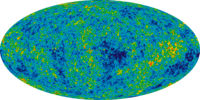
Photo from wikipedia
In this paper we discuss the commonly-used limiting cases, or approximations, for two-point cosmic shear statistics. We discuss the most prominent assumptions in this statistic: the flat-sky (small angle limit),… Click to show full abstract
In this paper we discuss the commonly-used limiting cases, or approximations, for two-point cosmic shear statistics. We discuss the most prominent assumptions in this statistic: the flat-sky (small angle limit), the Limber (Bessel-to-delta function limit) and the Hankel transform (large l-mode limit) approximations; that the vast majority of cosmic shear results to date have used simultaneously. We find that the combined effect of these approximations can suppress power by >1% on scales of l<40. A fully non-approximated cosmic shear study should use a spherical-sky, non-Limber-approximated power spectrum analysis; and a transform involving Wigner small-d matrices in place of the Hankel transform. These effects, unaccounted for, would constitute at least 11% of the total budget for systematic effects for a power spectrum analysis of a Euclid-like experiment; but they are unnecessary.
Journal Title: Monthly Notices of the Royal Astronomical Society
Year Published: 2017
Link to full text (if available)
Share on Social Media: Sign Up to like & get
recommendations!